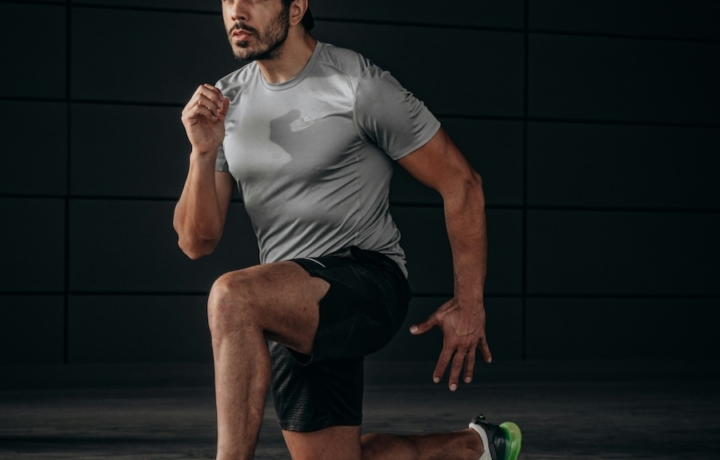Exercise
Back Pec Stretch

Back Pec Stretch
How to Perform
- Stand upright facing a wall, rack, or sturdy surface with your feet hip-width apart and engage your core for stability.
- Position one arm straight out to the side at shoulder height and place your palm flat against the wall or rack, with fingers pointing backward.
- Slowly rotate your torso away from the positioned arm while keeping your palm flat against the surface and maintaining a tall spine.
- Inhale deeply as you rotate, allowing your chest to open and your shoulder blade to retract.
- Continue turning until you feel a noticeable stretch across your chest, shoulder, and bicep, but stop before you feel any pain.
- Hold this position for 15-30 seconds while maintaining regular breathing and keeping your shoulders relaxed away from your ears.
- To release, exhale while slowly rotating your torso back to the starting position, maintaining control throughout the movement.
- Repeat on the opposite side, ensuring equal time and intensity for balanced flexibility development.
Important information
- Keep your arm at shoulder height throughout the stretch to properly target the chest muscles and anterior shoulder.
- Avoid forcing the stretch beyond comfort—a gentle, sustained pull is more effective than an intense stretch.
- If you experience any sharp pain or pinching in your shoulder joint, reduce the rotation angle or consult with a fitness professional.
- Make this stretch more effective by maintaining good posture, with your core engaged and spine neutral throughout the movement.

Back Pec Stretch
Exercise Details
Primary Muscles
Muscle Groups
Mechanic
Built for progress
Take the guesswork out of training
Create personalized AI-powered workout plans that evolve with you. Train smarter, track every rep and keep moving forward, one workout at a time.






The Back Pec Stretch targets the pectoral muscles (chest) and anterior deltoids (front shoulders), providing essential relief for these commonly tight areas. This accessible stretch helps counteract the forward-hunched posture many of us develop from desk work, driving, or looking at mobile devices. By opening the chest and stretching the front of the shoulders, this movement helps restore natural alignment and improves overall upper body function.
For those new to fitness, the Back Pec Stretch serves as an excellent introduction to upper body mobility work. It requires no equipment and can be modified to match any flexibility level. Beginners often experience immediate relief and a noticeable improvement in posture, making it a highly rewarding stretch for newcomers. The simplicity of this stretch also helps build body awareness – a fundamental skill for more advanced exercise progressions.
This stretch primarily targets the pectoral major and minor muscles along with the anterior (front) deltoids. These muscle groups tend to become shortened and tight from daily activities like typing, driving, and even sleeping positions. Regular stretching of these areas helps maintain chest flexibility, shoulder mobility, and can potentially reduce upper back and neck tension that stems from chronically tight pecs and front shoulders.
The Back Pec Stretch proves versatile enough for multiple phases of your workout routine. During warm-ups, it helps prepare the upper body for movements requiring shoulder mobility. As part of a cool-down, it assists in releasing tension built during chest or push exercises. For recovery days, this stretch promotes blood flow to healing tissues and maintains flexibility between training sessions.
As both a stretching and mobility exercise, the Back Pec Stretch contributes to better movement patterns throughout daily life and during other exercises. Regular practice improves thoracic extension, enables better overhead reaching, and can enhance performance in pressing movements by ensuring appropriate muscle length-tension relationships.
FAQ - Back Pec Stretch
Stand in a doorway with your arms extended to the sides at shoulder height, elbows bent at 90 degrees. Place your forearms on the doorframe, then gently lean forward until you feel a stretch across your chest and front shoulders. Hold for 20-30 seconds while maintaining good posture and breathing normally.
Aim to perform the Back Pec Stretch daily, especially if you work at a desk or spend significant time in a forward-hunched position. Include it both before upper body workouts and as part of your cool-down routine for optimal results.
Yes, the Back Pec Stretch can help reduce upper back pain caused by tight chest muscles pulling your shoulders forward. By releasing tension in the pectorals and anterior deltoids, you allow your upper back muscles to function in a more balanced position, potentially decreasing pain over time.
The most common errors include shrugging your shoulders toward your ears, overarching your lower back to compensate for limited shoulder mobility, and stretching too aggressively. Focus on quality over intensity, keep your core engaged to protect your spine, and remember that consistent, gentle stretching yields better results than occasional forceful attempts.
For beginners, reduce the stretch intensity by standing closer to the doorway or wall. More advanced practitioners can increase the stretch by positioning their arms higher on the doorframe, taking a larger step forward, or holding the position longer (up to 60 seconds).










